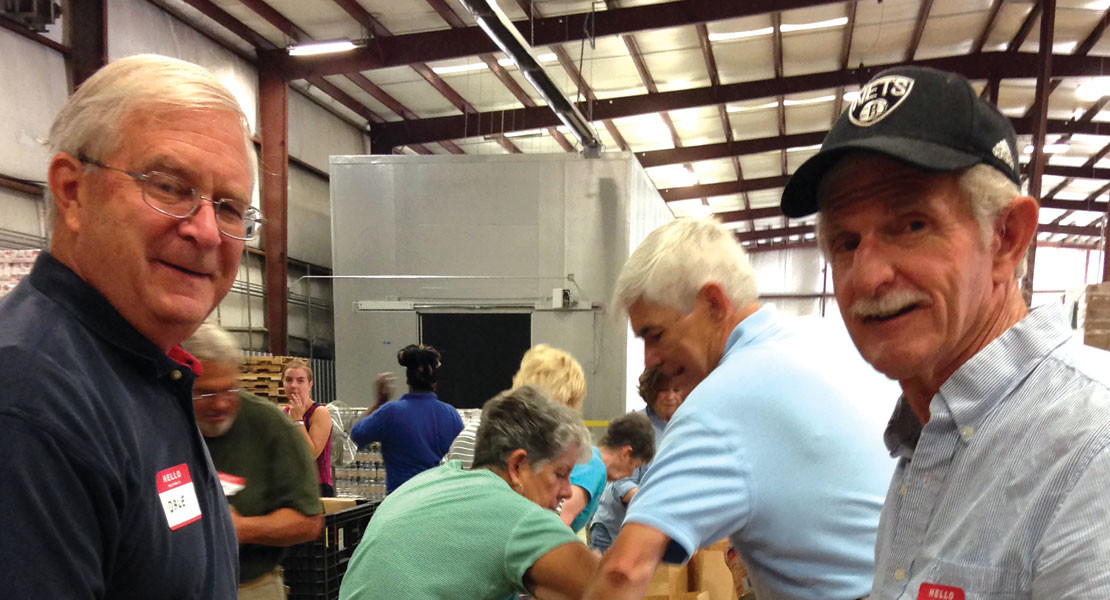Second Harvest Food Bank

Grasping the scope of hunger in America can be daunting. According to the Food Research and Action Center, about one in six Americans was sometimes unable to buy necessary food last year. And in a nation of nearly 320 million, that represents over 5 million hungry people.
It’s even more widespread in the Lehigh Valley. Estimates show that up to 25% of Allentown’s residents are food insecure.
Fortunately, the Second Harvest Food Bank of Lehigh Valley and Northeast Pennsylvania has offered a beacon of hope since its founding in 1982.
Feeding the feeders
“The basis of our operation can be confusing for the public,” said Paul Lynch, Second Harvest’s new director. “We aren’t a food pantry, and we don’t run soup kitchens. Instead, we serve as a warehouse for such organizations. You might say that we feed the feeding programs throughout the counties of Lehigh, Northampton, Carbon, Pike, Wayne and Monroe.”
No single food pantry could handle the amount of food that passes through Second Harvest’s doors – about 4,000 tons in 2014!
Their stock is primarily made up of canned goods; about 20% is fresh fruits, vegetables and meats. “We’re always willing to cooperate with local farmers,” Lynch said. “Many times, if a farmer can’t sell an entire crop, the only apparent recourse is to plow it under. But we can be an outlet for that usable food.”
Who gets it?
Food assistance recipients are often denigrated as loafers who just want “free stuff.” But in Lynch’s experience, that’s not the case.
“Most of them are laboring for low wages, often at multiple jobs,” he said. “They are hard workers trying to support their families,” while facing high living costs and limited transportation options.
And those Supplemental Nutrition Assistance Program (SNAP) benefits aren’t always the ticket to full bellies, either. Lynch said the typical benefit for a family of four is about $300 per month. Not per person. Total. At 12 meals a day, over 28 days, that’s about 89 cents per meal.
Fighting “food deserts”
Second Harvest can also impact regional “food deserts,” typical of low-income communities that have limited access to food choices and mobility. “Urban environments are especially challenging; residents with limited income often just go to the corner store, where selection is limited and food is more expensive,” Lynch said.
But people should have access to food that’s healthful, not just filling – and Second Harvest works with the United Way to help bring nutritious foods to these under-served areas.
Programs
Kids can get on the track toward good eating habits thanks to two major efforts involving Second Harvest.
“Cooking Matters,” a national after-school program, teaches basic culinary skills to elementary-school students. “Basically, we want to show people how to use available food to make good meals,” Lynch said.
Instructed by professional chefs and nutritionists, the “chef-ettes” learn by doing, not just by listening. At Cleveland Elementary, for example, students whipped up fish sticks (from scratch!), fruit salad and other goodies to celebrate their graduation night.
And children who qualify for school breakfast/lunch programs can eat better over weekends because of “Backpack Buddies.” “These low-income kids get two decent meals every day from Monday through Friday,” Lynch explains. “We provide an assortment of good foods for them to take home and prepare during weekends.”
Second Harvest also produces about 2,000 SUNShine (Serving UnderNourished Seniors) packs each month. These packages of staple foods – such as cereal, juice, various canned goods, pasta, rice and peanut butter – go to registered seniors and others.
Staff
Despite the complex logistics of receiving, cataloging, storing and distributing thousands of tons of foodstuffs, as well as general operations, maintenance and support for the organization, Second Harvest has just 17 paid staff members.
“Practically everyone else, from pantry staffers to warehouse workers, volunteers,” Lynch said. Working solo (or in groups of up to 50 people), those helping hands really make a difference; Second Harvest estimates that the weekly volunteer effort is almost like having three more paid staff members.
Funding
Tangible support for Second Harvest takes many forms. Food comes from the Commodity Supplemental Food Program, as well through the state’s purchasing system. Donations – whether in cash or in-kind – come from individuals, grants from foundations and corporations, and the food industry itself. These are just a few examples:
• In April, local reps from Dunkin’ Donuts presented a $15,000 check to Second Havest, based on coffee sales and coupon usage.
• Giant food stores donated 450 hams through its “Meat the Needs” program.
• Students and staff in the Parkland School District collected nearly 10 tons of canned goods during its 2015 food drive.
Future plans
Lynch anticipates a growing need for food assistance, and hopes to distribute additional fresh produce and meats. That’s why he’s excited about Second Harvest’s move to a new and larger facility in Nazareth: “Our current facility has about 26,000 square feet; the new building practically triples it, to 65,000 square feet. And we’ll have four times as much freezer space.”
But Lynch’s ultimate goal is a lofty one. “We hope that, one day, everyone will have comprehensive access to good, healthful food – and we’ll be able to go out of business.”
How to help
Donations of cash (every donated dollar buys the equivalent of seven meals) or food are always accepted. Volunteers can help pack boxes, work in the warehouse, or in the food pantries themselves.
For information, including volunteer requirements, donation arrangements, even a primer on running your own food drive – call 610.434.0875, or visit shfblv.org.
And if you, or someone you know, need food assistance, the site provides a simple, ZIP code-based way to locate food pantries or soup kitchens.
A Simple Way to Help
Do you want to help provide up to seven meals to those in need? All you have to do is “like” the Lehigh Valley Good Taste facebook page. Meris, Inc. will donate $1.00 to the Second Harvest Backpack Buddies program for every new like on our page. In recognition of Hunger Action Month, we’ve extended the donation campaign until the end of September.
It’s as simple as that. So, please, “Like to Donate.”















